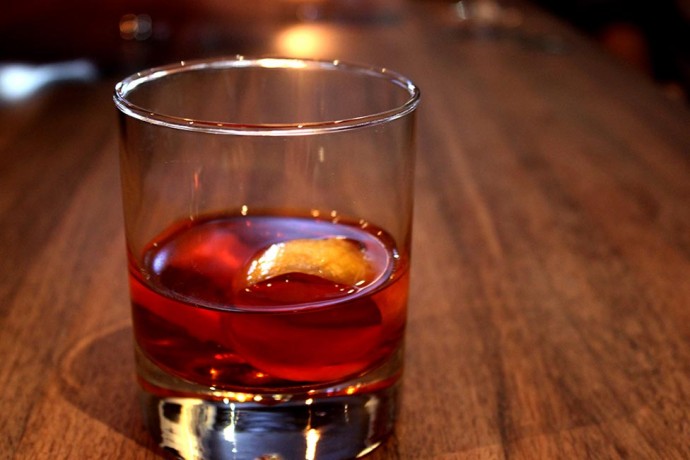Every drink has a story, but there are some that go so far as to define a city, a country, or even a whole culture. The Sazerac, the crown jewel of New Orleans’ vibrant and influential drinking history, is just such a cocktail.
Its relatively esoteric ingredient list—consisting of cognac, absinthe, sugar, and Peychaud’s bitters (though it varies depending on who you ask)—makes it a truly unique tipple, and one that’s earned its place in the pantheon of classic drinks.
What’s in a Sazerac Cocktail?
The Sazerac recipe, like so many other classic drinks, has evolved quite a bit since it was invented over 150 years ago, but contemporary recipes have more or less settled into two camps: the Classic Sazerac and the Rye Sazerac.
The Classic Sazerac traces its roots all the way back to the middle of the 19th century. Made with cognac, absinthe, bitters, and sugar, it’s really just a regional variation on the Cognac Cocktail, a drink that shares ancestry with the more famous Whiskey Cocktail and Old-Fashioned.
It was common to “improve” the standard cocktail recipe with a splash or rinse of absinthe, so the only thing that really sets it apart is the specific use of Peychaud’s bitters, a local New Orleans brand that was invented around the same time.
Get the Classic Sazerac Recipe
The Rye Sazerac, on the other hand, came about a few decades later. We’ll get into why in a minute, but the upshot is that this slightly more modern recipe replaces the cognac with rye whiskey, and generally uses local New Orleans anise liqueur Herbsaint (or something similar) instead of the traditional absinthe.
The preparation for both recipes is identical. You start by adding absinthe or Herbsaint to an Old-Fashioned glass (typically a single rather than a double), swirling it around, filling it with crushed ice, and setting it aside. Then, you simply combine the rest of the ingredients in a cocktail mixing glass with ice and stir until chilled.
Next, you pitch the crushed ice and excess absinthe from the Old-Fashioned glass and strain the chilled mixture into it, and finally, garnish with a lemon twist. It’s always good to express the oils from the twist and gently rub it around the rim of the glass to get the best effect.
The History of the Sazerac
So, the recipe is all well and good, but where did the Sazerac come from? The typical story goes that sometime around 1850, two New Orleans residents—one a bar owner, the other a spirits importer—came together at an establishment known as the Merchants Exchange Coffee House.
The importer, a man by the name of Sewell T. Taylor, had recently gotten his hands on a brand of cognac called Sazerac-de-Forge et Fils, and started selling it to the owner of the Coffee House, Aaron Bird (Taylor was actually the previous owner of the bar, so they were used to doing business together).
Bird began serving a Sazerac Cocktail, made with the Sazerac cognac and a kind of bitters produced by local apothecary Antoine Amédée Peychaud—hence, you know, the legendary Peychaud’s bitters. His patrons liked it so much that he ended up changing the name of the bar to the Sazerac Coffee House.
From there, the drink grew in popularity. After a decade or so, thanks to the outbreak of the Great French Wine Blight, cognac became scarce and the recipe was adjusted to use rye whiskey in its place. Later in the century, subsequent Sazerac Coffee House owner Thomas Handy eventually developed Sazerac Rye Whiskey specifically for use in the drink.
Then, in 1912, the sale of absinthe was banned in the United States due in large part to misconceptions about the effects of the wormwood it contains (people are still convinced it makes you go crazy, despite a complete lack of science to back that up), but also as a result of growing prohibitionist sentiment at the time.
New Orleans bartenders made do with other anisettes, with Herbsaint becoming popular after it was invented in 1934. Unlike Prohibition, though, the absinthe ban wasn’t repealed until 2007, so substitutes endured as the ingredients of choice for nearly a century.
Today, the Sazerac is enjoying a resurgence in popularity alongside numerous other classic cocktails, and thanks to the recent legalization of absinthe, people are finally able to make the recipe to its original specifications. Though the Rye Sazerac has plenty of history of its own, there’s something beautiful about traveling back to the early days of cocktailing to visit its ancestor.
The Sazerac also recently earned the distinction of becoming the official cocktail of the City of New Orleans, thanks to an enthusiastic campaign by Ann Tuennerman, founder of legendary cocktail conference Tales of the Cocktail. Previous efforts to recognize the drink had fallen flat in the Louisiana statehouse, but its recent popular revival pushed it over the edge.
It’s a fitting title for a drink that’s been an icon of the city for more than a century. Taylor, Bird, and Handy didn’t come up with a lot of recipes, but damned if they didn’t get this one just right.



